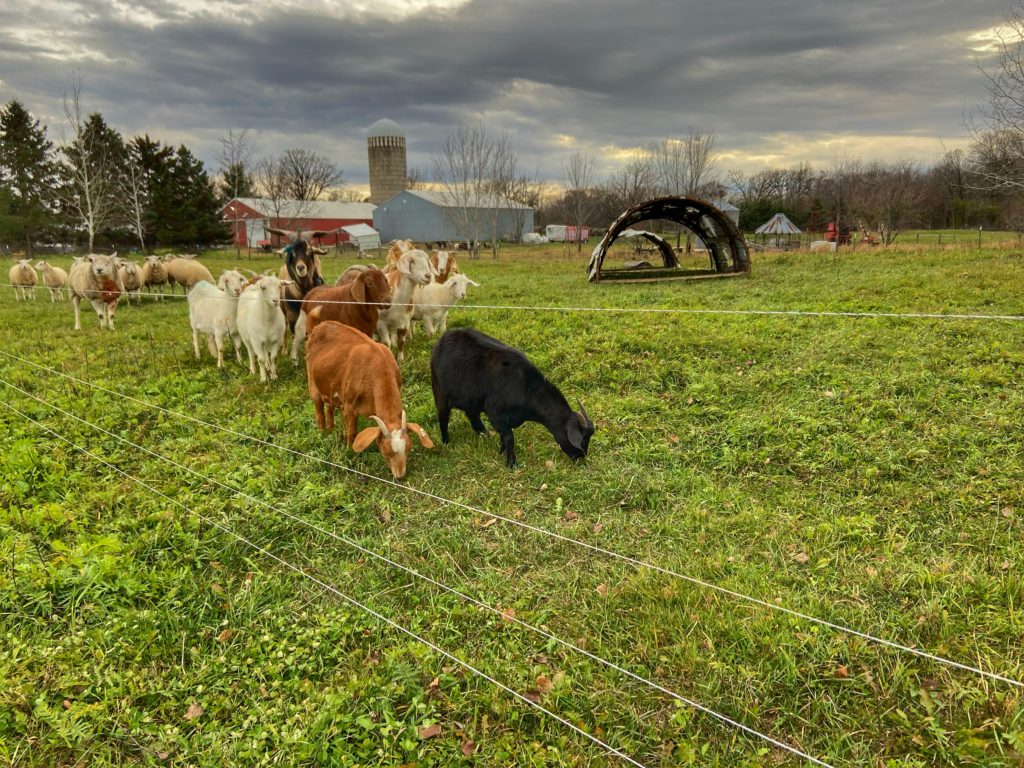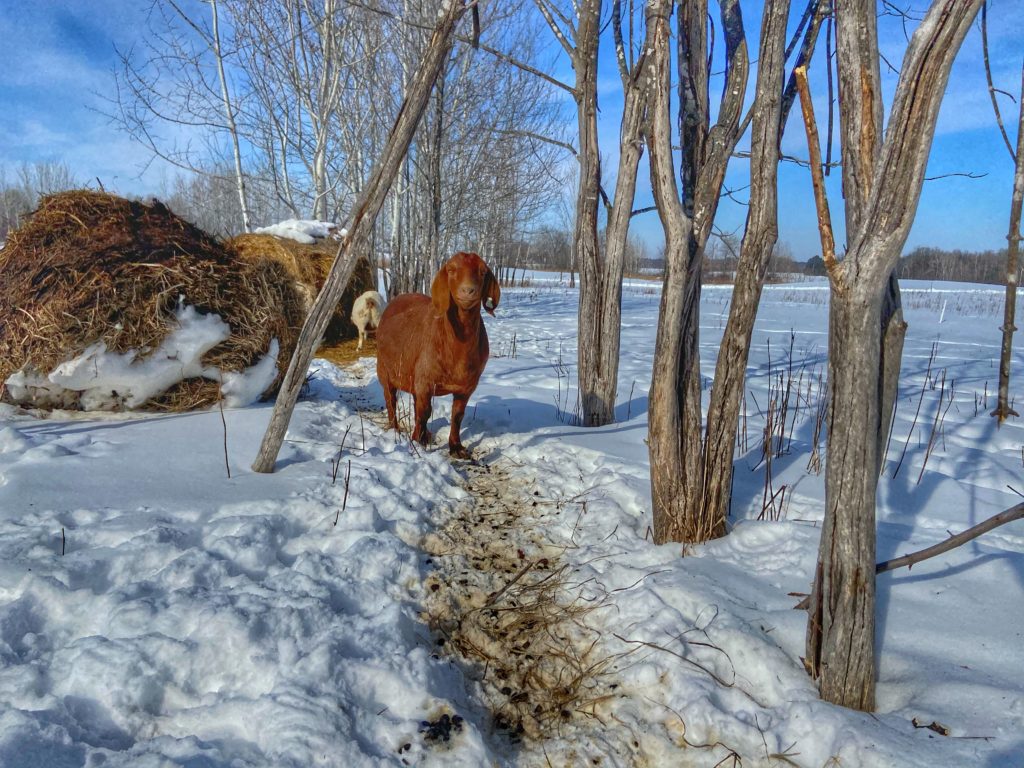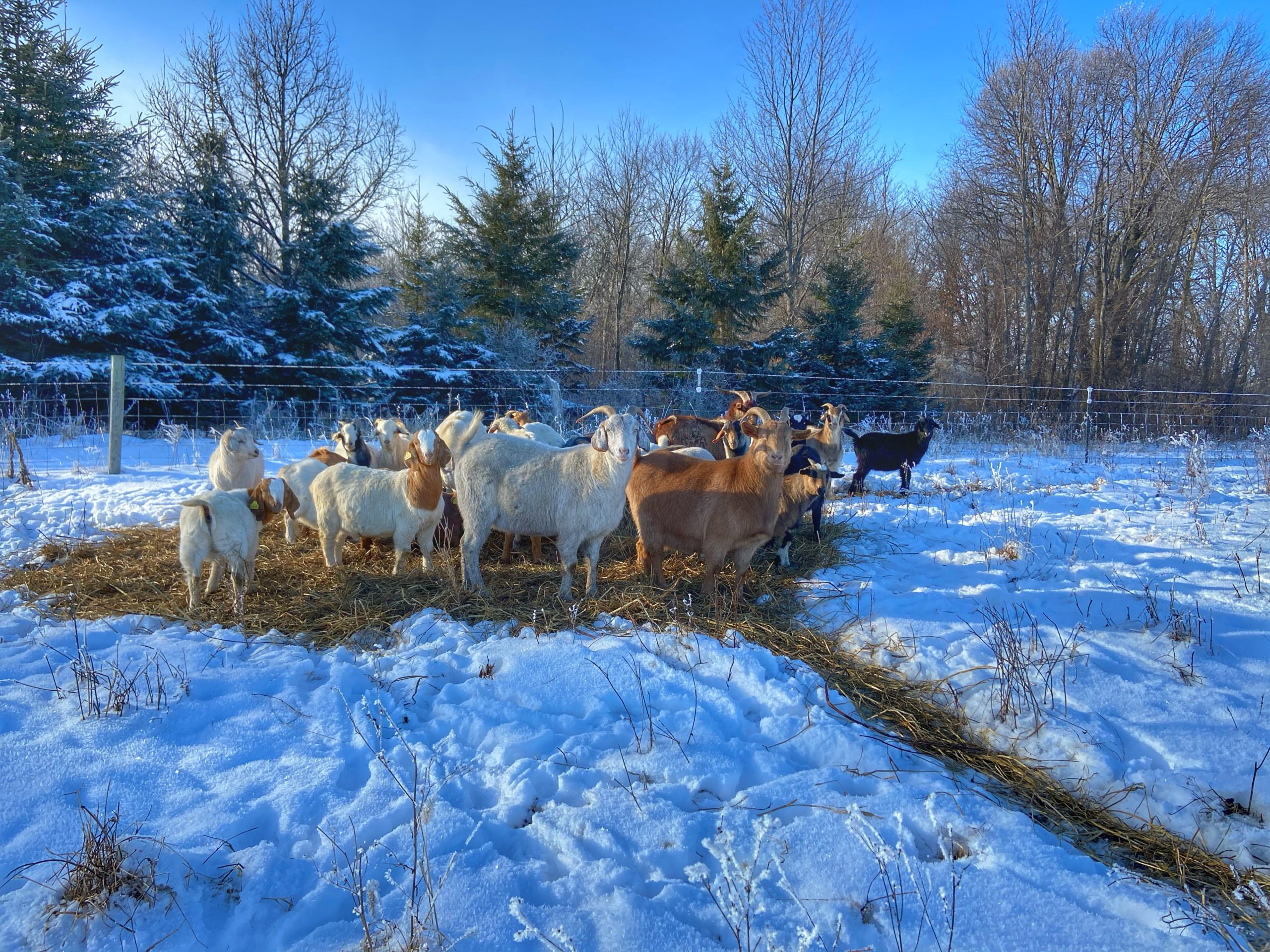Ensuring the well-being of your goat herd is a top priority as winter weather sets in for the season. Cold temperatures and weather brings a set of challenges that can impact the health and comfort of your goats.
It’s crucial to make sure the basics are covered for your goats, including a proper winter shelter, access to water, and winter feed.
This article will cover the essential elements of goat winter shelters, discussing topics such as structure, ventilation, keeping the area dry, bedding choices, and even the common misconception about providing heat for your goats.
Table of contents
Goat shelter in the winter
Your goat herd will need some type of shelter in the winter. The basic elements of a goat winter shelter include:
- Three-sides
- Draft-free
- Dry environment
Structure with at least three-sides
At a minimum a three-sided shelter should be provided for cover from the seasonal elements of winter in your area, such as heavy wind (typically from the north), snow or rain if you’re in a milder climate. The shelter serves as a windbreak for extreme conditions, especially when the wind chill is low.
Barns can use a door flap to keep wind and weather out of the barn, but still let goats in and out of the barn as they need.
In our barn, we use this approach. We screwed an old piece of carpet to the top of the opening with it hanging down to the ground. We’ve also used old rugs.
I really like the carpet since it’s stiffer and heavier, making it more durable holding up to the variation of weather that we get in Wisconsin with winter storms and snow.
Proper ventilation
While it’s important to keep drafts out of your goat barn or shelter, it’s still important to have enough ventilation to allow for some airflow.
It can be tempting to make the barn or shelter as “tight” as possible to minimize any cold air coming in. However, this will cause more problems than be helpful for your goat herd.
It’s actually better for your goats to have airflow, or ventilation throughout the winter. It may seem like ventilation is only for summer to manage heat, but during the winter it’s extremely important as well.
Inadequate ventilation or air movement combined with a group of animals in an enclosed barn will lead to moisture to build inside, even in the winter, which then can lead to pneumonia and other respiratory issues with goats and sheep (Merck Veterinary Manual).
After running into a pneumonia outbreak one spring on our own farm, we worked with University of Wisconsin Extension professionals to put in the right ventilation system for our barn, which was based on the dimensions of our barn and smaller stature of our goats.
To learn more about ventilation systems, read this UW Extension article: Ventilation in Dairy Buildings. While it’s focused on dairy barns, the concepts can still be applied to goat and sheep barns and shelters.
Keep the shelter dry
The winter shelter your goats use and the main loafing area should be kept as dry as possible. This can be accomplished several ways.
First take into consideration the location of your goat barn and where your goats will be located in the winter. Avoid low areas or where water tends to sit.
If you’re located in a climate where it doesn’t freeze in the winter, this is especially important since you’ll deal with mud and rain throughout the winter season.
However, if you’re in a colder climate, like we are in Wisconsin, you still need to keep in mind wet and muddy conditions that will occur in the spring and fall during the transition to and from winter. Even a month or two of these conditions can cause health issues with your herd.
Keep the barn dry itself by regularly bedding the pens. Read more about this in the bedding section later in this article.
Keeping these main areas dry is important for not only comfort, but animal health. Constant exposure to wet conditions can cause health issues for your goats.
Ongoing wet conditions can potentially lead to hoof health issues, such as hoof rot or scald in the hoof (MacKay) and udder issues with mastitis (Erskine).
Goat bedding
The right goat bedding in your barn will also help keep your goats warm during the winter.
Best bedding for goats
So what’s the best bedding for goats? Straw is one of the best options for bedding given its ability to keep more volume, therefore letting urine and manure fall below it and keeping animals drier.
Other bedding options include bales of shredded corn stalks or soybean residue. In any of these options, you’ll want to make sure there isn’t any mold in the bales since your goats will likely nose through the bedding to eat some of it.
Pine shavings for goats
Often people will tend to use pine shavings for goats since they’re easy to buy from farm stores or other retail options like Tractor Supply.
However, wood shavings are not a great option for goats. Once they’re wet they get clumpy and stay. In contrast with straw, urine will go through the straw to the ground keeping the top layer dryer.
Additionally, pine shavings can also lead to respiratory problems, such as pneumonia, with goats given the small particle size of the shavings and the dust (MacKay).
Deep litter method
A common approach to goat bedding in colder climates is using the deep litter bedding or deep straw bedding method.
This approach is where you keep adding layers of straw over the old bedding. The top layer stays dry, while the bottom gradually starts to breakdown, composting to create heat.
This type of barn bedding when combined with natural body heat will contribute to keeping your goats warm during the winter.
Depending on how deep the bedding layer may get, you may need to clean the bedding out of the barn partway through the season.
However it is possible to keep adding layers to the existing bed pack as long as the top layer remains dry.
Do goats need heat in the winter?
Goats do not need a heat source in the winter months. In fact in most cases, providing heat in a barn, heat lamps or even using goat jackets can make it harder for your goats to adapt to colder temperatures and seasonal changes.
As temperatures gradually drop with the seasonal changes to winter, your goats will naturally adjust to the changing temperature by growing a thicker coat of hair.
One way to observe your goat’s ability to maintain heat is to take a look at their winter coat while they are outside when it’s snowing. If there’s a lay of snow on top of their hair and it’s not melting, that means their winter coat is doing a good job of insulating their body and not releasing too much heat.
Health and nutrition will help influence how goats can regulate their body temperature and stay warm in the winter. See the following sections in this article to learn more about how that works.
Goat jackets are not necessary
Goat jackets or coats may cause your goats to not grow a thick coat of hair to help provide them with adequate insulation during winter (Metzger).
Additionally jackets, coats or blankets will compress the layers of hair, compromising the natural insulating properties of the animal (Colorado State University). This will actually cause goats to not be able to naturally keep themselves warm.
When jackets or heat lamps might be needed
There are a few instances where a goat jacket or supplemental heat, such as a heat lamp, may be needed as a supplement for a brief period of time.
- If a goat is sick and has poor body conditioning.
- If newborn goats are born during the winter. A few days with heat or jackets may suffice. However, once the kids are actively moving around and nursing on their own, extra heat or jackets are not necessary.
Access to fresh water
Goats will continue to need access to fresh water throughout the winter months.
Often water demands increase in goats during this time since they are eating hay and not fresh pasture, which has a much higher moisture content.
Without water livestock may not eat as much and may lose body conditioning (University of Minnesota).
Depending on your geographical location, you will need to consider how you provide water to your goats if it gets below freezing.
Goat water heater options
There are several approaches to making sure your goats have access to water without it freezing.
- Frost free drinker or heated waterer. This is a stationary water trough that automatically fills and is typically heated so it does not freeze. While these options are more expensive, they greatly reduce your time filling water tanks and ensures your goats always have access to water. This set up is also very energy efficient.
- Heated water bucket or trough. This is typically a standalone bucket with no insulation that has a heating element at the bottom. These buckets need to be plugged into electricity to work.
- Regular bucket or water tough with a drop in tank heater. This option allows you to use a larger stock tank to provide water. Water heaters can be dropped into the tank and then plugged into an outlet. An issue with this set up is that goats can sometimes pull the drop in heater out of the tank.
If you’re filling water tanks by hand, it can help to have a frost free water hydrant located near your barn, rather than hauling water from your house or other heating building.
The frost free hydrant is installed below the frost line (which varies depending on your climate). Then you can fill tanks with a hose, but be sure to either use a heated hose or bring your hose into a heated building so it doesn’t freeze solid when you’re not using it.
On our farm we’ve found that using the expandable hoses (think As Seen on TV) with filling tanks from a hydrant works really well. When you’re done, just coil them up in a bucket and bring them inside.
Winter water on our goat farm
Over the years we’ve just done water tanks with drop in tank heaters with some heated buckets when needed with small pens. We’d fill with either a heated hose or the collapsible hose trick from a frost free hydrant in our barn.
As our herd has grown it has become a lot of work to fill tanks on a daily basis.
It’s also hard to find tanks that are large enough for a lot of goats to drink from. Most are smaller in size, where our herd would drink all the water. Or, the larger tanks are built for cattle or horses and are too deep for our goats and sheep to access the water on the bottom.
Last year was the first season we started using frost free water drinkers. We had a well installer put underground lines and put in the drinkers. We’re using Ritchie brand drinkers and have been very happy with them.
Winter goat feed
The last part of keeping goats warm in the winter has to do what you feed goats in the winter.
You might wonder why does that matter? The way a goat’s stomach works, actually creates additional heat to keep their body warm.
What to feed goats in the winter?
Goats should be fed hay in the winter. This is based on the needs of their unique digestive system and how it functions.
Goats are considered ruminants, which means they have a four changer stomach: the rumen, reticulum, omasum and the abomasum. The rumen breaks down the outage, which is the hay, through fermentation.
It’s the fermentation process that produces heat internally to help the goat stay warm (Cornell). In fact, to make sure goats produce this internal heat, hay should be offered free-choice 24/7.
Winter feeding goats on our farm
On our farm we feed our goats round bales of hay free choice, out in our pasture using collapsible hay feeders.
Each time we feed new bales of hay we move it to a new location in the field to take advantage of the benefits of the hay residue and natural fertilizer the goats and sheep leave behind. This process is called bale grazing.
Another benefit of feeding our goats outside is that it allows them to get exercise and fresh air, and it also helps keep the barn cleaner.
Often on sunny winter days, we’ll find the goats loafing on the old bale residue in the sunshine.
With extreme winter conditions we will feed hay in the barn when weather permits. However, most of the time the goats and sheep are going outside to eat their hay.
Helping goats get adjusted to colder weather
Helping goats get acclimated to colder weather is an important process to follow as your weather changes from fall to winter (University of Minnesota). This process will help your goats handle the more extreme weather conditions that can happen in winter.
So how does this work? As an example, on our farm we keep our goats outside as long as possible with their portable pasture shelters and tree cover as the temperatures drop and season change.
I don’t give them access to the main barn until we have snow. If it’s a wet and muddy fall, I may let them have access sooner.
By doing this they develop a thick coats to better prepare them for colder weather later in the season.

Goats in snow
On our farm we’ve found that goats do well in the snow, as long as they’ve been acclimated to the cold weather and have access to a dry shelter so they can get out of the winter.
Depending on how deep the snow may get, we will plow a path from the barn to the frost free water trough and to their hay feeders, which are both outside.
We will often plow the snow so it acts as a windbreak, providing extra protection from harsh winds for the goats while they are outside.

Selecting heartier goats for winter
If you’re in a colder climate you might also consider building a herd that’s hearty and can handle winter conditions.
There are a few factors to consider when selecting heartier goats or adding new genetics into your herd:
- Source from a goat herd in a similar climate and with similar management practices
- Look for goats or goat breeds with cashmere quality in their hair coat. Cashmere is actually a characteristic versus just being a breed. Goats with this hair quality grow a thicker coat over winter.
- Retain breeding stock within your own herd that does well in cold conditions.
References:
- Overview of respiratory diseases of sheep and goats. (2023). Merck Manual Veterinary Manual. 2023.
- Ventilation in Dairy Buildings. University of Wisconsin Extension.
- MacKay, E. (2022). Contagious footrot in sheep. Merck Manual Veterinary Health.
- Erskine, R. (2022). Mastitis in Goats. Merck Manual Veterinary Health.
- Metzger, M. (2018). Winter management tips for goats. Michigan State University Extension. Sheep and Goats.
- Colorado State University. 2017. To blanket or not to blanket? That’s a good cold weather question.
- Digestive System of Goats. Cornell University.
- Preparing your cattle for severe winter weather. University of Minnesota
First published November 2011.
Related blog posts:

What kind of hay is best for goats?
We’ve been happy with a legume grass mix, primarily focusing on alfalfa as the legume. It has a higher protein %, which the goats tend to eat more than grass and is more nutritional for their needs.